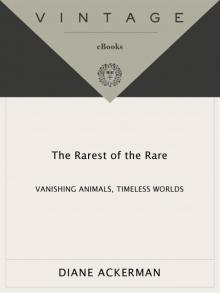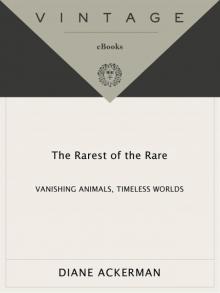- Home
- Diane Ackerman
The Rarest of the Rare Page 6
The Rarest of the Rare Read online
Page 6
Later, as I lie in my narrow cabin, my thoughts begin to roam over the past week. For seven days we have been cruising a river that extends not just in miles but in time and imagination. The Amazon region is the largest tropical rain forest in the world. The river drains 20 percent of all the world’s fresh water into the sea. Nowhere else is there so much life per square mile. Fifty thousand species of plants and fungi, a fifth of the world’s bird species, three thousand species of fish (ten times as many as in all European rivers put together), and millions of species of insects share its tangled layers. The largest snake in the world, the anaconda, and the largest beetle, the dynastes, dwell here, along with other giants. From its richness, we have extracted cacao (for chocolate), rubber, quinine, Brazil nuts, chicle (for chewing gum), and an array of heart medicines and anti-cancer drugs. But tropical rain forests are being destroyed at about ninety-five thousand square miles per year; unless something is done, it will all vanish in my lifetime.
We began our journey in the remote reaches of the river, drifting with the current through a view of Nature carnal, green, and radiantly renewing, moving closer each day to the civilized deliriums of twentieth-century life, the duty-free emporia of Manaus, the neon carnivals of Rio. The river flows in only one direction, like time, and appears to be seamless. But up close one finds a lightly feathered surface, a plumage in which there are small puckers, rapids, and backwaters—also like time. Most Brazilians live on the civilized outline of their country, not in the wild chaos that inhabits the heart of Brazil.
In addition to the expedition’s leader, Iain Prance, a world-class botanist who is head of Kew Gardens in London, there are other naturalists, and Mo Fortes, a famous and somewhat notorious Amazon guide who grew up in one of the small river towns. Each day, we rise early, often before sunrise, and climb into lurching Zodiacs to hear the rain forest waking up; prowl along the tributaries; visit Indian villages to trade, watch dances, have our ship’s doctor attend the ill and leave medicines; talk with the river people; and, my favorite, take walks into the vine-thick jungle, under canopies effervescent with life. We began in Peru, passed swiftly through Colombia, and now are deeply in “Brazil, where the sun dines,” as John Donne wrote, and the equatorial sun scorches body and soul. It doesn’t feel or look like the Temperate Zone sun, whose rays, because of the tilt of the earth, strike at an angle, have to pass through a lot of atmosphere, and wash out a bit when they hit the ground. At the equator, the sun shines straight down like a heat lamp, focusing its energy onto a smaller space. It is possible to get a sunburn right through light clothing, and night doesn’t dally: it cascades all at once, a black velvet curtain tumbling down.
One morning, Iain returned from the local Ticuna village with a strange tale. Four people had died mysteriously in the village that week, and the villagers were in mourning. Iain offered his condolences, as did we all. We were bringing them a repaired generator and a supply of medicines. They welcomed us warmly but explained that it was not a happy time for them. A community of two thousand, they are part of the most populous tribe in the Amazon (about seventy thousand). They are petite and have sharp cheekbones but otherwise soft features, straight black hair tied back with barrettes and ribbons, and a startling smile—they file their teeth to sharp points to mimic piranhas. Famous for their arts, they showed us animal carvings in whose simple lines and glowing resin shone a candor and unselfconscious joy. Is it naïve art? If it is naïve to marvel. Often the children tie ropes to the carved animals and drag them through the streets to play. There was some confusion about the people who died. They were poisoned by a forest plant. But was it an accident or was it suicide? The suicide rate is very high among the Indians here, as it is else where. The river is their home, but it is also a quick slide into the twentieth century. The chief of that village has been wise with the money he’s made from tourists, spending it on medicine, schooling, and other village needs. One of the first things they wanted was electricity. When boats sail by, they are covered in lights. The villagers wanted the ship’s people to see lights on the riverbank and know there was a town there, an established people. What they make of us is hard to know. We find their ways strange, but to them we are probably another natural component of their environment, one with its own rules, taboos, and private dramas. We are pasty-faced giants who prefer to live in cold rooms, who dress in long-sleeved clothes in the hot jungle and are forever spraying themselves with the scent of pine and peppermint, and whose faces flush like cooked fish after a short walk. Only adults from our ships visit them. They said, “Good heavens, you have a very strange culture. Doesn’t anyone in your culture have children?”
At one house, a man brought out his wares, including two live yellow-footed tortoises, whose heads and tails had been forced back inside the shells and held there with sticks. All shell, the tortoises looked like giant netsuke. They might know that torment for weeks or months, awaiting the cooking pot. So we bought the two tortoises, to set them free at a safe distance up the river. Among the many wares for sale there were no dolphin parts. In Belém, down the river and further along in civilized time, we will find dolphin vulvas and penises for sale in the voodoo market. But on most of the river the dolphins are protected by elaborate myths, and no one hunts them. Like the mythic silkies of Scottish legend, dolphins are thought to come ashore and make love with young women from time to time. So an illegitimate child is said to be the child of a dolphin, and if you kill a dolphin you may be killing your own father.
On the table beside me tonight stands a pot of hot tea made by crumbling and steeping the bark of casca preciosa, a fragant relative of the sassafras. It has a bouquet that scents the mouth, the hair, the room, that washes up over your face as you drink. Sipping its sweet, violet-scented narcotic as lightning begins to prowl behind the peninsula, I drift into a river of dreams.
By early-morning light, we set out in our Zodiacs, and soon we pass a woman sitting on a caustic-sapped log, acaçú, literally, “that which burns the asshole,” to wash her clothes in the river in the ancient way, though she uses a twentieth-century plastic scrub brush, which she has probably bought from one of the itinerant peddlers who travel up and down the river, selling salt (used for drying fish) and other staples and household goods. A praying mantis flutters into the boat. It is a small brown-and-white insect with protruding eyes, horns on its back, and long waving antennae in front. Its jagged poise is beautiful as it preens its long legs and makes slow and purposeful gestures. Fish leap from the water, fleeing predators. What a perfect getaway: hurl yourself straight into another dimension of reality, as flying fish do, and suddenly appear elsewhere and elsewhen. Three little girls row out in a bark canoe, flash hundred-watt grins, stand up suddenly, and jump into the water. One man on shore holds up a pair of binoculars and watches us, the exotic primitive tribe madly unfolding colored ponchos from their packs and squirming into them because rain has begun to fall like a wall of rubber. Children go on playing in the shallows; adults continue to swim, wash clothes, mend their boats and nets. It is only rain. This is a rain forest. Holes in the banks, carved by walking catfish in April or May, when the water level rises as much as thirty feet, make the mud look like a condominium of birdhouses. On some of the lighter trees you can see the dark waterline, and many trees have large, exposed root systems to grab nutrients directly from the seasonal flood.
In a tall, bushy-topped tree, a dozen hanging nests belong to oropendolas, birds that have a symbiotic relationship with a number of animals. They like to build their nests in trees where there are hornets’ nests so that the hornets, which attack parasitic botflies, will keep them from the chicks. The oropendolas also allow cowbirds to lay eggs in their nests so that the cowbird chicks, which are born with their eyes open, will eat botflies, too. The siren song of the oropendola is so complex and willowy that river people often build their houses under an oropendola-inhabited tree. The song begins with a wet, two-stage warble, a liquid undulating smooch, part throb, p
art Moog synthesizer, and ends with the sound of a debutante throwing kisses underwater. Birds of Colombia, by Steven Hilty and William Brown, scans it as “EEE-eee-D’D’Clock-agoogoo,” but there is a mellow swoon in the final stages of the call that’s seductive and magical.
Behind the Zodiac, the wake makes a perfect white water butterfly, wings outstretched and outlined in spray. The forty-horsepower engine gnaws like a buzzsaw, and its blade cuts through the reflection of trees in the opaque brown water as we scout the shore for birds, mammals, unusual plants. Along the bank lie logs waiting for high water and their trip to the mills, when they will be laced together in a large raft. A gash of light splits the water about ten yards away, as if a window sash has been thrown open, and then a pink dolphin surfaces and dives back through its window. Oh! I say: like the dolphin, I take a small gasp of air. Suddenly four more pink dolphins arc out of the water in front of us, and one surfaces right next to the boat with a small, explosive breath. Close to the ancestral whale, these dolphins and their platanistid relatives are frequenters of the Amazon, Ganges, Yangste. On their snouts they have short, tactile whiskers to feel for food. At the riverbank a striated heron stands with its back to the sun so it can hunt in its own shade. A brown sphinx moth with a bright orange body planes low at eye level, followed by a heron, floating pterodactyl-slow with long rippling neck: a stately white apparition. We spot a tassel-topped tree, Triplaris, which has hollow stems inhabited by stinging ants whose venom feels like hot wires. Lianas drip from the trees, anchoring in so many places that it is hard to fathom where the vines begin and end. The brown river bubbles gently; fish leap up, mouths open. We hear the sound of a trigger cocking, then the low mournful call of a patoo, a bird that can mimic dead sticks. A sun bittern flashes the big false eyes of its wings. Trees, swaddled in leafy vines, look like the feathered feet of huge owls. A kingfisher sounds like a child’s rubber squeaky toy. It is early morning on the Amazon, and the birds sing their territorial anthems. They do not mean to be beautiful. They cannot help themselves. A capuchine (organ grinder) monkey moves through the top of a tree, sampling fruit and dropping what doesn’t appeal to it, like someone testing chocolate bonbons. The sound of fingers dragged across a rubber inner tube comes from a bird. When we drift near a fisherman and his son in a bark canoe, David calls in Portuguese: “Good morning, sir. How’s it going? Catch much today?”
The man smiles, gestures to the bottom of the boat, where freshly caught fish lie in a pool of water. “Good morning,” he says.
“The people would like to have a look at the fish, if that would be possible,” David asks in a respectful and polite subjunctive, on behalf of the collective desire of our boat, “the people,” as he puts it.
The man grins and maneuvers his tippy boat next to ours.
“You’ve done well this morning, eh? Aruaná, peche cascudo, curimatão, piranha. Would it be possible to see the bony-tongued fish there?”
The man lifts the long, glistening fish in his hands. How Himalayan his lined face looks, a reminder that he shares genes with Mongols and many other peoples.
“I’m obliged,” David says, and opens the complex and fascinating mouth of the fish, whose tongue is a thin bone. Bony-tongued fish like to eat monkey feces and often wait under a tree where monkeys live. Then David picks up an armored catfish, which has a shovel nose, strange upside-down omegas for pupils, long sensory barbell appendages on its face, and beautiful black stripes. Next David takes a reddish cashew piranha from the old man, opens up its stomach with a machete, and smears the contents onto his finger to reveal that it holds mainly fish scales. The piranha nips at other fish to feed. It is not by choice the voracious carnivore of gothic stories and monster movies; unless it is cut off from its usual food supply and is famished, as it might be in an isolated swamp or lake, it is happy enough nibbling scales from fish. David hands the fish back to the fisherman, who generously offers us some to take back with us, if we like.
“No, thank you. That is kind of you,” David insists. “We are glad to look at them, and learn about the life of the river. But, if it wouldn’t be too much trouble, I know we’d enjoy seeing how you use your net to fish.”
The man’s face lights with the pride of shared craft, and he picks up the net as if it were a hemp skirt hung with lead weights, secures one end in his mouth, and tosses it in an arcing spiderweb over the water, then watches it sink down into the shallows where fish wait. There is wonderment in the shape the net takes through the air, its calm descent, how it vanishes into darkness. And the man watches our faces, smiles, drags the net back, and tosses it again and again. A small bird with a bright yellow belly like a dollop of lemon pudding perches on a branch and calls, Bem ti ver! (“Good to see you”), its name in Portuguese. In English, the bird’s name is onomatopoeic, too: Kiskadee!
Later, at a peddler’s boat, we stop to chat. Inside there are stacks of bananas and bagel-shaped bread; large fillets of salted fish are drying on the roof, swarmed over by flies. He offers us the hospitality of his house, just up the hill, behind which there is a large lake; his wife shows us her turtles, parakeets, and two hives of African killer bees, which she keeps for honey (each hive is locked inside a log that opens and closes like a sea chest). Digging at the base of one of the manioc plants in a field, she exposes the root to show us its long white fingers. Painted on the front of her house are the words CASA FEEM DEUS. I ask her what feem means, and she looks puzzled, laughs, struggles to explain. After an awkward moment, we laugh, too. Feem is a contraction of the words fé (faith) and em (in). I have come from the wilds of North America to ask her what faith is, and I should not be surprised if she marvels at my question. Before we go, she notices how we admire a large green calabash hanging on a tree in her front yard. The only calabash on the tree, it is about the size and weight of a bowling ball and will be dried and carved to use as a bowl. When she offers it to us, we must accept. It is so generous of her; it would be rude to refuse.
Back on the river, we see a large pod of pink dolphins, so we cut our motor and drift right into the center of it. With a snuffle and snort, the dolphins breathe through blowholes as they surface. What a range of pinks—some look like erasers, others are luminous or dusky. We are close enough to be able to recognize individuals. I lean over the side of the boat and put my head in the water to listen for the rapid clicks of their sonar. Whoosh! Whew! they blow as they surface. In pairs and threes they gallop through the river. When the rain starts, we head for shore and climb up a bank to a house on stilts. Inside there are shards of American culture: a Mickey Mouse towel, a photo of Lassie, six lightbulbs for when the house gets electricity, magically shiny pots and pans (one, with a funnel center, looks like an angel-cake pan). The man who lives there pulls out two long benches, the way one puts an extra leaf in the table when company arrives, and invites us to sit. It is simply assumed that we are welcome and may hang up our hammocks in his house if we wish to.
Instead, when the rain stops, we stroll through his backyard and see a mother sloth cradling her baby up in a tree. About once a week, the sloth climbs down the tree, digs a pit, and defecates into it. This exposes the sloth to predators, but by putting its feces at the base of the tree, not dropping them at random, it invests in the future of its home. Algae live in its fur, which gives it a greenish tint. Moths live there too, as well as beetles and ticks. For long minutes, I stand and watch the mother sloth, who is completely immobile until, struck by a ravishing thought, she gently lifts her head.
When the other Zodiacs have joined up with ours, Iain leads us through the rain forest he knows so well. There is much to see: the pau roxo (Peltogyne) tree from whose deep purple wood beautiful bowls are made; the lyre-shaped leaf of Dioscorea, a vine used as raw material for birth-control medicine because it mimics estrogen; a young kapok tree covered in sharp gooseflesh spines so that rodents can’t climb or woodpeckers peck. At first, it seems such a tree must have bounty overflowing that it needs to protect, but perhaps
not—there were Renaissance fortress cities supremely well protected, but not because they contained more treasures than other towns. The botanists test trees by making a small slash, looking for latex, noticing the smell, the stigmata of the cambium, a certain readable oozing. As Iain makes a tiny slash in the bark of a strangler fig, white latex tears well up. How old is that tree? I wonder. It is hard to tell the age of a jungle tree because they don’t lay down one ring a year. In areas that flood, like this one, many trees have flying buttresses and sprawling, shallow root systems to clutch at the ground. This is not a temperate forest, where sunlight is plentiful, the loam thick and rich, and predictable trees have predictable needs.

 A Natural History of Love
A Natural History of Love The Rarest of the Rare: Vanishing Animals, Timeless Worlds
The Rarest of the Rare: Vanishing Animals, Timeless Worlds The Zookeeper's Wife: A War Story
The Zookeeper's Wife: A War Story The Human Age: The World Shaped by Us
The Human Age: The World Shaped by Us A Natural History of the Senses
A Natural History of the Senses One Hundred Names for Love: A Memoir
One Hundred Names for Love: A Memoir The Rarest of the Rare
The Rarest of the Rare